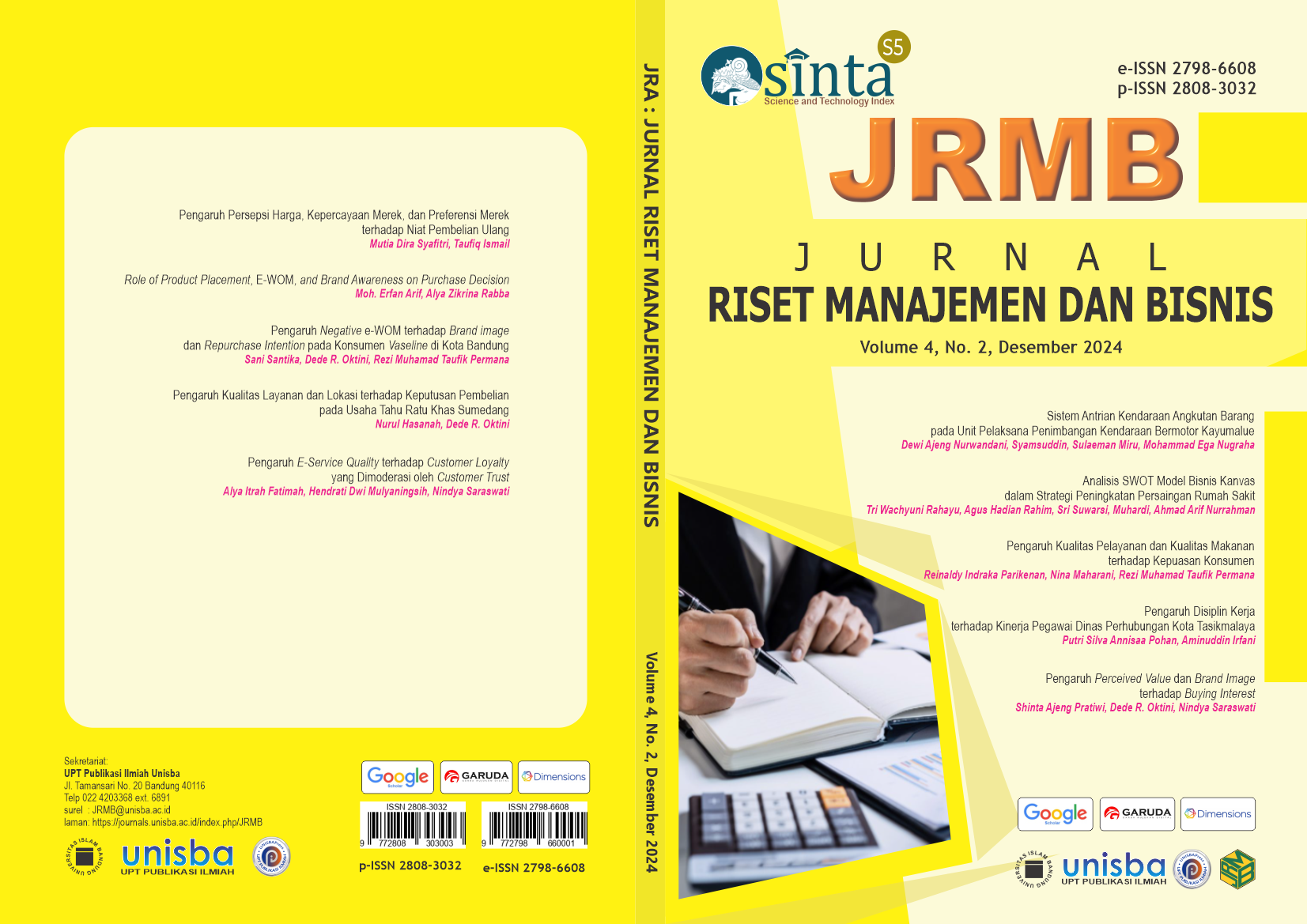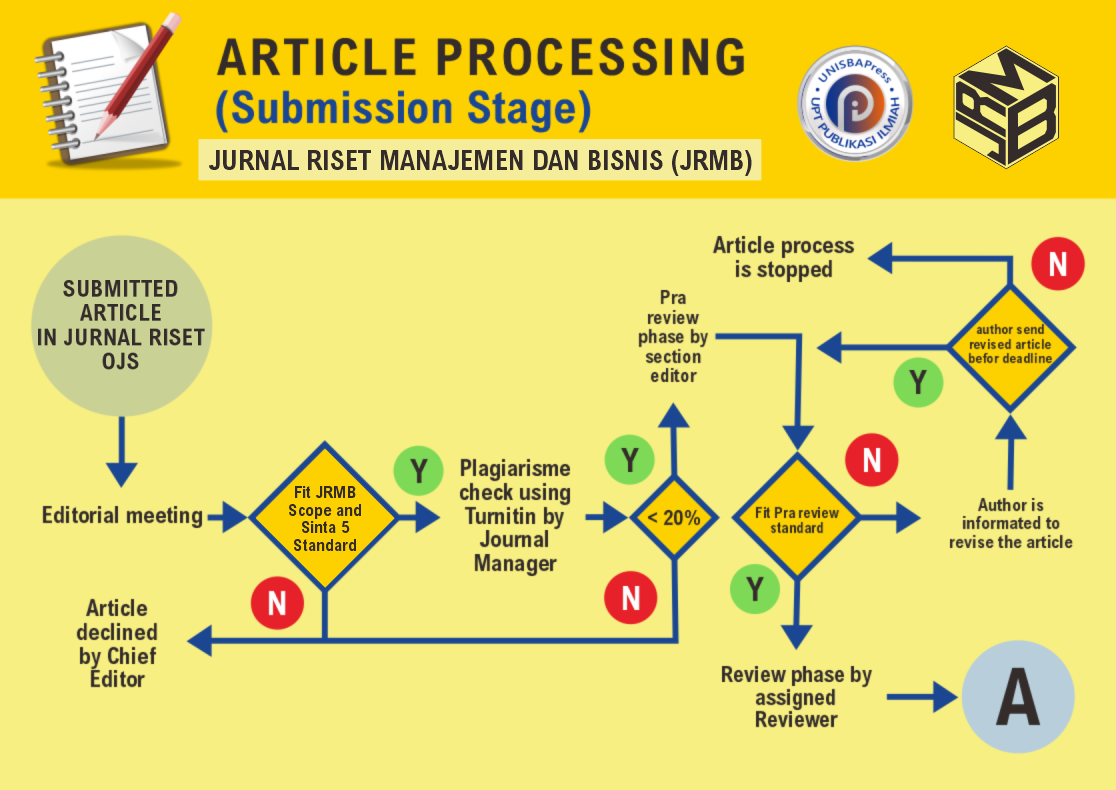Pengaruh Negative e-WOM terhadap Brand image dan Repurchase Intention pada Konsumen Vaseline di Kota Bandung
DOI:
https://doi.org/10.29313/jrmb.v4i2.5477Keywords:
Negative Electronic Word of Mouth, Citra Merek, Minat Pembelian UlangAbstract
Abstract. The skincare industry has experienced extraordinary and rapid development, where another thing that supports the development and marketing of skincare products in Indonesia is using social media. The phenomenon that is currently being discussed is that many big skincare brands are being boycotted due to supporting Israel, one of which is Vaseline products. The aim of this research is to determine the influence of Negative Electronic Word of Mouth on Repurchase Intention which is mediated by Brand Image. This research method uses a quantitative method with descriptive verification research type, the population of this research is people in the city of Bandung aged 12-45 years. with a total sample of 150 people selected using purposive sampling technique. This research tests three hypotheses using path analysis techniques and the Sobel test. The results of this research show that Negative Electronic Word of Mouth has a negative and significant effect on Brand Image. Negative Electronic Word of Mouth has a negative and significant effect on Repurchase Intention. Also, Brand Image mediates the influence of Negative Electronic Word of Mouth on Repurchase Intention.
Abstrak. Industri skincare telah mengalami perkembangan yang luar biasa dan pesat dimana hal lain yang mendukung perkembangan dan pemasaran untuk produk skincare di Indonesia yaitu salah satunya menggunakan media sosial. Fenomena yang sedang dibicarakan pada saat ini yaitu banyak brand skincare besar yang diboikot akibat mendukung Israel salah satunya produk Vaseline. Tujuan penelitian ini adalah untuk mengetahui pengaruh Negative Electronic Word of Mouth terhadap Repurchase Intention yang dimediasi oleh Brand Image. Metode penelitian ini menggunakan metode kuantitatif dengan jenis penelitian deskriptif verifikarif, populasi penelitian ini adalah masyarakat di Kota Bandung yang berusia 12-45 Tahun. dengan jumlah sampel sebanyak 150 orang yang dipilih menggunakan teknik purposive sampling. Penelitian ini menguji tiga hipotesis dengan menggunakan teknik analisis jalur (path analysis) serta uji Sobel. Hasil penelitian ini menunjukkan bahwa Negative Electronic Word of Mouth berpengaruh negatif dan signifikan terhadap Brand Image. Negative Electronic Word of Mouth berpengaruh negatif dan signifikan terhadap Repurchase Intention. Serta, Brand Image memediasi pengaruh Negative Electronic Word of Mouth terhadap Repurchase Intention.
References
Apsari, V. (2020). Peran Kepercayaan Sebagai Mediasi Pengaruh E-Wom Negatif Terhadap Niat Beli Pada E-Commerce Jd.Id. In Jurnal Ilmu Manajemen (JIM) (Vol. 8).
Bojei, J., Khalid, H., & Nadarajan, G. (2018). Influence of Negative eWOM on Switching Intention. Business Management and Strategy, 9(2), 67. https://doi.org/10.5296/bms.v9i2.13747
Djaslim, S. (2003). Intisari Pemasaran dan Unsur-unsur Pemasaran. Linda Karya.
Gienov, J. R., Mahani, S. A. E., & Permana, R. M. T. (2023). Pengaruh Brand Image dan Flash Sale Program Terhadap Purchase Intention. Jurnal Riset Manajemen Dan Bisnis, 101–108. https://doi.org/10.29313/jrmb.v3i2.2876
Hersetyawati, E., Arief, M., Furinto, A., & Saroso, H. (2021). Negative Electronic Word of Mouth and Its Effect on Repurchase Intention in Energy Drink Products: Moderation Role by Social Networking Sites. Journal of Theoretical and Applied Information Technology, 31, 24. www.jatit.org
Muis, M. R., Gultom, D. K., Jufrizen, J., & Azhar, M. E. (2020). Model Elektronik Word of Mouth: Citra Destinasi, Kepuasan dan Loyalitas Wisatawan. Jurnal Ilmiah Manajemen Dan Bisnis, 21(1), 1–19. https://doi.org/10.30596/jimb.v21i1.3694
Nafshya, M., Putri, A., Putu, I., & Sukaatmadja, G. (2018). Peran Brand Image Memediasi Pengaruh Kualitas Produk Terhadap Niat Beli Ulang. 7(11), 5983–6010. https://doi.org/10.24843/EJMUNUD.2018.v7.i11.p7
Pentury, L. V., Sugianto. M., & Remiasa. M. (2019). Pengaruh e-WOM Terhadap Brand Image dan Purchase Intention Pada Hotel Bintang Tiga di Bali. JMP (Jurnal Manajemen Perhotelan) Vol. 5, No. 1(E-ISSN: 0216-6283).
Pratama, R., & Ahmad Hafidh Nurmansyah, A. (2024). Pengaruh Electronic Word of Mouth terhadap Repurchase Intention yang Dimediasi oleh Brand Image Produk Sabun Mandi Merek Lifebuoy di Kota Bandung. Syntax Idea, 6(1), 123–136. https://doi.org/10.46799/syntax-idea.v6i1.2875
Purnapardi, M. S., & Indrawati, T. A. (2022). Nomor 1 Jurusan Manajemen Fakultas Ekonomika dan Bisnis Universitas Negeri Surabaya 2022. In Jurnal Ilmu Manajemen (Vol. 10).
Rezeki, S. R. I., Fani Sartika, Tengku Kespandiar, Ita Nurcholifah, & Wenny Desty Febrian. (2023). Analysis of The Influence of Brand Image and Negative Electronic Word of Mouth on Repurchase Intention of Ice Cream Aice Consumers. JEMSI (Jurnal Ekonomi, Manajemen, Dan Akuntansi), 9(5), 2050–2054. https://doi.org/10.35870/jemsi.v9i5.1538
Thurau, Thorsten Henning. (2004). Electronic word of mouth via consumer – opinion platforms: what motivates consumers to articulate themselves on the internet? Journal of Interavtive Marketing. Vol.18, No.1
Zharfan, A. A., & Kusuma, N. I. (2023). Brand Image: As a Mediating Variabel in the Relationship between E-WOM and Repurchase Intention of The Botol Sosro. Indonesian Journal of Business Analytics, 589-606, 3(3).










